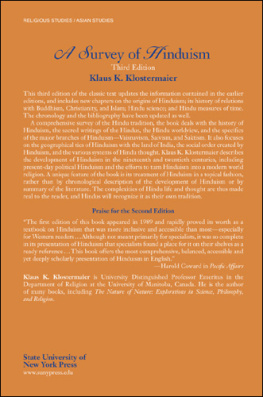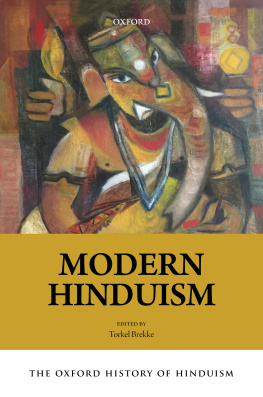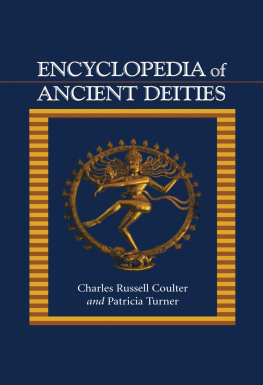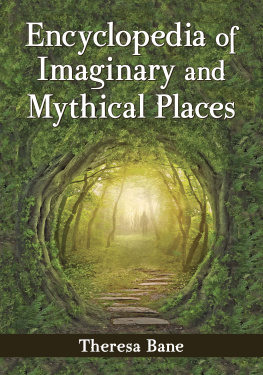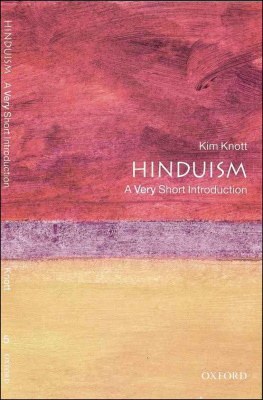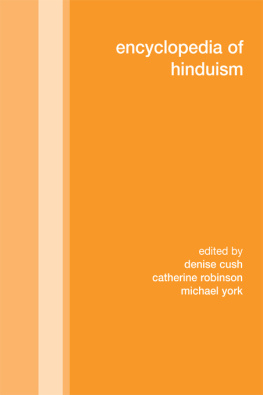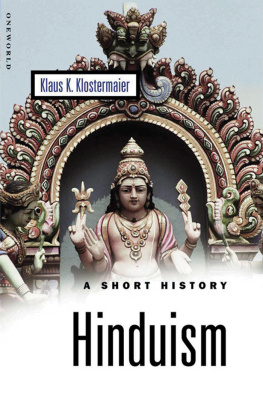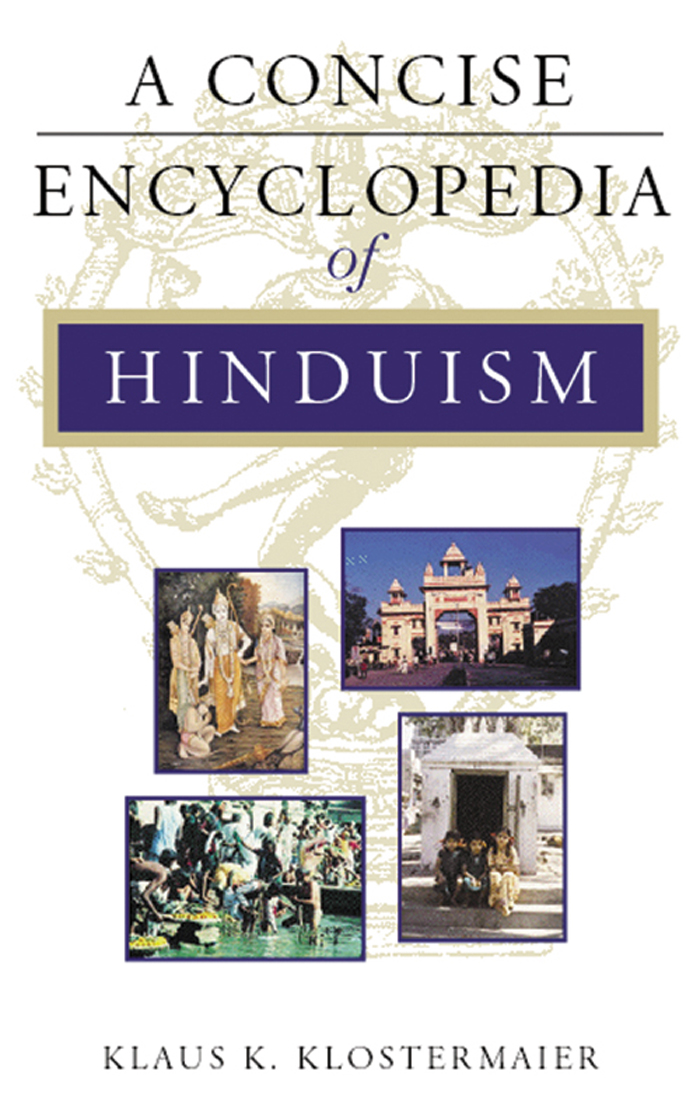A CONCISE
ENCYCLOPEDIA
of
HINDUISM
A CONCISE
ENCYCLOPEDIA
of
HINDUISM
KLAUS K. KLOSTERMAIER

A CONCISE ENCYCLOPEDIA OF HINDUISM
This ebook edition published by Oneworld Publications, 2014
First published by Oneworld Publications, 1998
Oneworld Publications
10 Bloomsbury Street
London WC1B 3SR
England
www.oneworld-publications.com
Klaus K. Klostermaier
All rights reserved
Copyright under Berne Convention
A CIP record for this title is available
from the British Library
ISBN 978-1-85168-175-4
eISBN 978-1-78074-672-52
Cover design by Design Deluxe
Stay up to date with the latest books.
special offers, and exclusive content from
Oneworld with our monthly newsletter
Sign up on our website
www.oneworld-publications.com
Contents
Acknowledgements
T he author and publishers wish to thank the following for permission to reproduce material in this volume:
Circa Photo Library ().
Every effort has been made to trace and acknowledge ownership of copyright. If any credits have been omitted or any rights overlooked, it is completely unintentional.
Preface
T o write a concise encyclopedia of Hinduism is a daunting task considering the enormous diversity of what is called Hinduism and its history of over five thousand years. There is not a single statement that would be accepted by all Hindus as expressive of their religion, not a single symbol that all would agree upon as typifying what they worship.
The many different religions and philosophies embraced by the over 800 million Hindus in India and the 45 million Hindus all over the world today supply the background to what is offered in this Concise Encyclopedia of Hinduism. The followers of particular paths within Hinduism will probably find the information offered on their specific traditions insufficient - there simply is no way to do justice to any of them within the context of this enterprise. Nor is it possible to do justice to all the great persons, women and men, who over the millennia have contributed through their lives and thoughts to one or more aspects of the Hindu traditions.
The purpose of this encyclopedia is to provide basic information on many expressions of Hinduism and to explain important terms that one might encounter reading more technical literature in the field. Many of the entries interlock and the reader is requested to consult terms and expressions that are capitalized in the text itself. Unless otherwise noted, the technical terms used are Sanskrit. English translations have been supplied in one place only. Given the uncertainties of Indian chronology in many cases dates attached to authors or works are tentative; other sources may have different dates.
Care was taken to establish a balance between people and places, scriptures and philosophical systems, art and architecture, mythology and history. However, given the vastness of the country, the huge population, the long history, the rich mythology, choices had to be made. One of the choices made was not to include entries on living scholars of Hinduism. The names of some of them will be found as authors in the bibliography.
A great many entries are concerned with mythology. While mythology has its own truth, it goes without saying that no historical truth claims are associated with the stories told, often in a variety of versions, that cannot be harmonized. Even the stories connected with historical personalities before the modern period are often inextricably interwoven with mythical elements, and are hagiographic rather than critically biographical. Hindus have always placed greater emphasis on meaning than on factual correctness. It would be pointless to qualify every entry by adding disclaimers like Hindus believe or Hindu tradition reports etc.
Likewise, given the enormous diversity of traditions within Hinduism, it goes without saying that no Hindu believes or accepts everything that is here presented as Hinduism. It would again be rather tedious to underscore that fact by specifying in each and every instance where Hindus are mentioned, that some Hindus or many Hindus believe or think this and that. Using inclusive terms like Hindu and Hinduism implies always and by necessity a certain blurring of real and important distinctions and generalizations that have to be taken with a grain of salt.
Given the constraints of space and the very nature of such a work the Concise Encyclopedia of Hinduism is no substitute for comprehensive monographs on either Hinduism as a whole or any of the topics mentioned. The bibliography is meant to direct the user of this work to more detailed descriptions of issues that by necessity could only find brief mention herein.
Since is was decided that Sanskrit words would be transliterated with diacritics, as they are used in scholarly works, a few hints as regards pronunciation will be in place. Most Sanskrit vowels (a, e, i, u) are pronounced like Italian vowels - a macron (, , ) indicates doubling the length of the vowel. Diphthongs (ai, au) are pronounced like double vowels. There are three semi-vowels: (pronounced ri), y (pronounced like y in yes), v (pronounced like w in Swami). The pronunciation of most of the consonants is similar to that of their English equivalents. A major difference are the aspirates: kh, gh, th, dh; the h sound is clearly perceived like the h in hot- h ouse. Sanskrit has many different t and d and n sounds, expressed in transliteration through dots under the letter (, , h, h). While the difference (and the marking) is important to recognize the meaning of the word, English does not have equivalent sounds. and are pronounced like sh.
Sanskrit is fond of compounding words, which makes it difficult for most non-Sanskritists to pronounce them. To facilitate reading, the Concise Encyclopedia of Hinduism separates the various elements of compounds through short dividing dashes. Sanskrit words do not have accents. The basic rule is to stress the first syllable, unless there are long vowels in later syllables. All long vowels in a word receive a stress, even if there are more than one.
Proper names of individuals and organizations have usually been reproduced as used by these, without attempting to transliterate them according to the system mentioned above. Indian words that have become part of the English vocabulary have also been left without diacritics. Plural formations have been made by adding an -s to the singular, disregarding the Sanskrit inflections. Likewise no distinction has been made between masculine and neutral noun formations; the final -m indicating (in many cases) that the neutral form has been dropped.
Information has been drawn from many sources. Instead of attaching references to individual entries, a bibliography has been added at the end, which should allow the reader to pursue the issues raised here in greater depth. Cross-references within the entries are intended to provide fuller information by directing the reader to similar or related matters. They are indicated by text in small capitals, e.g. AVATRA. For readers wishing to explore Hinduism from a thematic viewpoint, the Thematic Index on pp. 23643 will refer them to the appropriate entries. The Chronology on pp. 21621 gives a full picture of the major events through the life of the faith.


